Time of Troubles (1598 - 1613)

Fedor Nikitich Romanov, Filaret (1553-1633),
son of Nikita Romanov and Eudoxia Gorbataya-Shyuskaya;
Patriarch of Moscow in 1619-1633
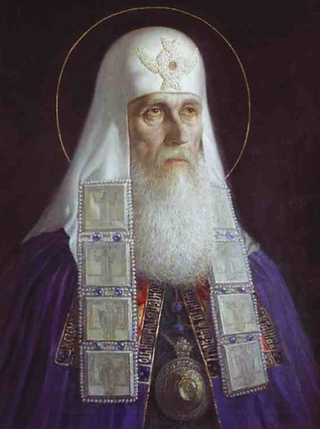
Hermogen (secular name Yermolay) (1530-1612),
Patriarch of Moscow in 1606-1612
In July 1607 Dmitry II appeared, who was able to gather large forces and eventually set up his own capital in Tushino. The tsar's agents made a concerted effort to discover his true identity but failed. The man was about the same height as murdered Dmitry I but only vaguely resembled him. Many sources identified him as a Russian who had lived for few years in Belorussia before assuming the identity of Dmitry II or a baptized Jew named Bogdan. In spring of 1608 Dmitry II's reinforced army advanced upon Moscow, routing the tsar's army at Bolkhov. The approach to Moscow by the rebel army and the presence of large numbers of the Polish troops in it finally convinced the tsar to speed up peace negotiations with an envoy from Sigismund III. The tsar agreed to release all Polish subjects who had been held captive since Dmitry I's assassination, including his widow and father-in-law as well as the Polish ambassador. Marina Mniszech was specifically ordered not to refer to herself as 'tsaritsa' anymore and, under no circumstances, was she to recognize the new impostor as her husband or to join him. In return for the tsar's display of good faith, the Polish envoy made a false promise that Sigismund III would recall his subjects from Dmitry II's camp. However, in September 1608, Marina and her father were both 'captured' by the rebels and brought to Tushino. After the secret negotiations, Marina 'recognized' the impostor as her husband.
In February 1609, the tsar's nephew, Mikhail Skopin-Shuisky, concluded an agreement with the Swedish king's representatives in Vyborg. In return for the transfer to Sweden of the fortress of Korela and its surrounding towns and villages as well as the Russian renunciation of any claims to Livonia, Karl IX agreed to provide an army to be paid by Vasily IV. The agreement was extremely unpopular in the border area being trasnferred to Sweden, but the tsar gambled that the foreign troops would help him save his crown. Skopin-Shuisky advanced against the enemy from Novgorod on 10 May 1609, along with the Russian troops of his own. Dmitry II's court was by this time deeply in debt and most of his soldiers were unpaid. Some of his Polish commanders began to negotiate with Sigismund III, who had invaded Russia in September 1609 and laid siege to the fortress of Smolensk. Only Sigismund III's lack of ready cash to pay prevented them from immediately departing from Tushino for Smolensk. Dmitry II himself grew increasingly desperate as news of Skopin-Shuisky's relentless advance provoked desertions and fights among his remaining advisers. The suspicious and violent Roman Rozynski eventually put the 'tsar' under close watch and threatened to behead him for plotting with Rozynki's enemies. However, Dmitry II managed to flee in disguise to Kaluga in late December 1609. He soon received a big boost when, in February 1610, Marina made her way to Kaluga accompanied by a small detachment of foreign mecenaries. He made another unsuccessful attack on Moscow, but was killed, while half drunk, on 11 December 1610, by a Tatar princeling, Peter Urusov, whom he had flogged.
In March 1610, Skopin-Shuisky made a triumphal entry into the capital widely hailed as the hero who had ended the siege of Moscow and eliminated the threat posed by Tushino. Skopin-Shuisky was by this time far more popular than Vasily IV himself and was being secretly promoted as the next tsar. Although he immedaitely rejected the radical idea of toppling his uncle, the paranoid tsar learned about his nephew's flirtation with treason. The tsar thereupon invited Skopin-Shuisky to a private audience and less than a month after that meeting, the popular commander died mysteriously. People claimed that he had been poisoned by a jealous relative, either the tsar himself or his brother Dmitry, who was, in fact, hoping to succeed the childless ruler some day. Skopin-Shuisky’s death, whatever its cause, proved to be a disaster for the unpopular tsar. Few people believed he sincerely mourned the loss of his nephew and many suspected him of involvement in murder. Vasily IV now quickly chose his incompetent and extremely unpopular brother Dmitry to replace Skopin-Shuisky as his main commander.
On 16 July 1610, one of Dmitry II's principal commanders, Dmitry Trubetskoy, in a ruse, approached the capital and urged Moscow to get rid of Vasily IV while he eliminated Dmitry II. Then he proposed both sides to join forces, elect a new tsar and put an end to the civil war. The very next day, a huge crowd assembled on Red Square demanding the overthrow of Vasily IV. The boyars at this point finally arrested the tsar in spite of strong protests from Patriarch Hermogen. They offered to grant the deposed tsar a virtually independent province if he would cooperate, but he sullenly refused. In frustration, the boyars took the tsar to his residence, beat him up and had him forcibly tonsured as the monk Varlaam. He was then placed under close guard in a Kremlin Monastery.
In the days following the coup against Vasily IV, Filaret - with the patriarch's approval - proposed his fourteen years old son, Mikhail, as a candidate for the throne, but neither he nor anyone else could gain a majority during the boyar council deliberations. For that reason, the boyars voted to convene a zemsky sobor for the important task of choosing a new tsar. In the meantime, a council of seven boyars was appointed to rule.
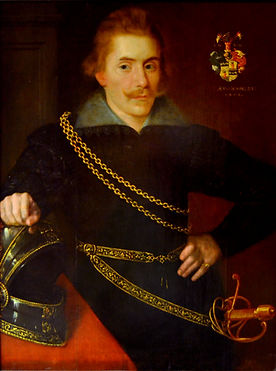
Jacob de la Gardie (1583-1652),
a Swedish statesman and a soldier
The council of seven boyars now quickly agreed to invite young Wladyslaw Vasa, the son of Sigismund III and Anne of Austria, to rule, and on 17 August 1610, the Russians swore an oath of loyalty to Tsar Wladyslaw. Although many courtiers approved of Wladyslaw's selection, a number of boyars and Patriarch Hermogen flatly rejected the idea of a foreign tsar. For several months the unpopular boyars continued to labor under the illusion that Tsar Wladyslaw would eventually show up and share power with them. Those men were, therefore, at a loss to explain why the Polish troops began a series of devastating raids on Russian towns and why Sigismund III renewed the siege operations against Smolensk (which had been temporarily suspended). Finally it was clear that Sigismund III aimed to convert Russia from Orthodox religion to Catholicism. He refused to agree to the boyar's request to send his son to Moscow and his conversion to Orthodoxy. Instead, he proposed that he should reign as Regent instead. This unrealistic proposal led to a resumption of hostilities.
Ever since the collapse of Vasily IV's regime and the council of seven's agreement to have a Polish prince as Tsar, Karl IX felt that he had a good excuse to grab Russian territory for himself. As the Polish military intervention in Russia gained momentum, Sweden's direct intervention in north also picked up speed. The Swedish forces briefly laid siege to Novgorod in August 1610. In September, they besieged the fortress of Korela and it finally fell to them in March 1611. By spring 1611, Novgorod again came under siege by a Swedish army commanded by Jacob de la Gardie. In June, he began the secret negotiations with representatives from the city who requested military assistance against the Poles and secretly offered the Russian throne to one of Karl IX's sons. In the meantime, Novgorod itself was to be placed under the protection of Sweden and de la Gardie was to be allowed in to serve as its military governor.
Karl IX, just like Sigismund III, began to behave as a conqueror, completely disregarding all the agreements made with the Russians by his representatives. No Swedish prince hurried to become a tsar and Sweden failed to assist the Russians against the Poles. Instead, de la Gardie seized complete control of Novgorod and the surrounding area and began Sweden's conquest and annexation of many border towns and fortresses, cutting Russia off from the Baltic Sea by early 1612. Swedish troops also renewed their attempt to conquer Russia's far north, fully intending to capture the port town of Kola (Murmansk) and Russia's extremely important new White Sea port town of Arkhangelsk in order to close them both to European ships. The plan was to gain control of all of Russia's exports and to force merchants to buy those products at Sweden's Baltic ports. Fortunately for the Russians, the Swedes failed to capture or shut down those northern ports, which became indispensable for Russia in the 17th century.
Chosen by his fellow citizens to heed Patriarch Hermogen's call, who was urging the populace to rise against the Poles, a local butcher named Kuzma Minin convinced his fellow citizens to raise money for an army to cleanse Russia of foreign interventionists and to restore order in the realm. Next, Minin chose the brilliant Dmitry Pozharsky, then recovering from his wounds on a nearby estate, to be commander-in-chief of the new militia being formed. With patience and determination, Pozharsky managed to build a strong army and looked for the first available opportunity to put it to good use.
The provisional government in Yaroslavl was strongly committed to liberating Russia and convening a zemsky sobor to choose a new tsar. Minin and Pozharsky avoided publicly picking a favorite candidate, but they adamantly opposed Ivan Dmitryevich, son of Dmitry II and Marina Mniszeck. Several leading Russian candidates for the tsar were, of course, still in Polish captivity. In spite of that, Filaret's close relatives were quite active and floated the prospect of his now fifteen years old son, Mikhail, as a candidate for the throne. Since young Mikhail was at that time still in Polish occupied Moscow living with his uncle Ivan (a member of the despised council of seven), there was understandably very little enthusiasm in Yaroslavl for his candidacy.
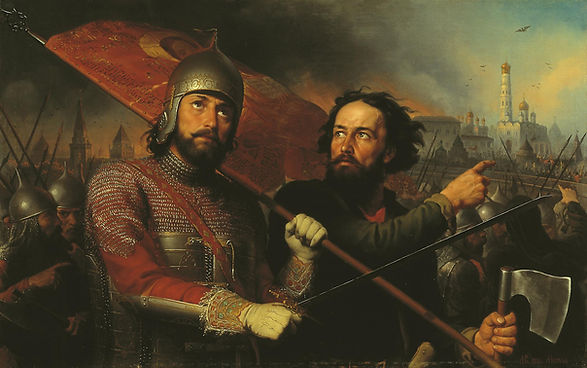
Kuzma Minin (right) with Dmitry Pozharsky by Mikhail Scotti (1850)
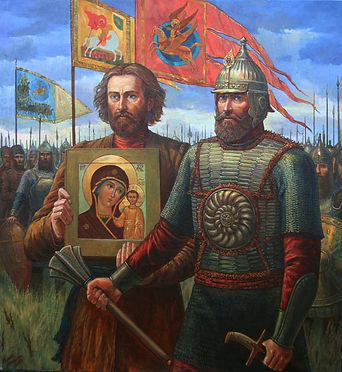
Kuzma Minin with Dmitry Pozharsky in 1612
Prince Pozharsky himself cleverly hinted at the possibility of a Swedish tsar in negotiations with the Swedish interventionists, who were then holding Novgorod and many other Russian towns. The Swedes displayed considerable interest in the prospect of 'Swedish Tsar' and, as a result, Pozharsky was able to negotiate a critically important truce with them in June 1612 that secured his northern base and allowed him to move his army toward Moscow and to concentrate on liberating the capital from the Polish interventionists. After the battle on 22 October 1612, the Poles retreated to the Kremlin, and on 24-27 October the nearby Polish army was forced to retreat. The garrison in the Kremlin surrendered to the triumphant Pozharsky.
Mikhail Romanov was unanimously elected Tsar of Russia by a national assembly on 21 February 1613, but the delegates of the council did not discover the young tsar and his mother, Xenia Shestova, at the Ipatyev Monastery until 24 March. Finally, on 2 May, Mikhail entered the holy city as bells rang from all the churches. The rambling complex of royal residences were being hurriedly repaired to be ready for the coronation. Thus, in the first months, the new tsar stayed in the palaces of his nobles, who traditionally had their own residences within the Kremlin. On 21 July 1613, Mikhail was crowned in a ceremony intended to show unity among the various factions that had joined together to end the civil war.
The Romanovs were particularly nervous about nostalgia for Tsar Dmitry I and from the outset of Mikhail I's reign anyone who claimed Dmitry was still alive or even dared to remember him fondly was brutally punished. Others were tortured or imprisoned for comments favorable to any pretender or past ruler whose legitimacy the new regime disputed. In summer 1614, the new tsar's generals defeated the army of a Cossack leader Ivan Zarutsky, a faithfull supporter of Ivan Dmitryevich, son of Dmitry II and Marina Mniszech. Zarutsky had to flee to Astrakhan due to the desertion of his supporters, however, the people of Astrakhan decided that Zarutsky and his clique didn't meet their interests and organized an uprising against him. Zarutsky fled to the Ural steppes, where he, Marina Mniszech and her son Ivan would be caught by the Cossacks and handed over to the government. The Cossack leader was impaled on Red Square, Marina Mniszech was starved to death and the four years old Ivan was hanged from the Kremlin walls.
In the early years of his reign, Mikhail I wisely asked the members of the zemsky sobor to remain in Moscow in order to help him to rebuild the shattered Russian state. In fact, he made far more extensive use of the zemsky sobor than any other tsar and he was wise to do so. The experienced patriots in that assembly maintained the contact with the towns and provinces they represented and they provided the central government with valuable information about conditions far from the capital. Unlike some of the young tsar's greedy courtiers, the zemsky sobor delegates helped with the difficult tasks of restoring the state administration and renewing the flow of taxes to fund the day-to-day operations and to maintain military forces capable of challenging foreign interventionists.
Continuing the warfare in the Novgorod region, the exhaustion of the Swedish troops and severe fiscal problems at home threatened to reverse their gains made in Russia during the Time of Troubles. That prompted the new king, Gustav II Adolph, personally to lead a military campaign into north Russia during 1614. After some initial success against the Russians, Swedish army got bogged down in a siege of the strategically and economically important town of Pskov, which stubbornly resisted the Swedes throughout 1615-1616. By then, fiscal and domestic political pressures on the frustrated king forced him to begin serious negotiations to end the war in Russia. And after months of complex diplomacy in which Pozharsky played an important role, both countries agreed to sign the Treaty of Stolbovo on 27 February 1617. By the agreed terms, Sweden restored Novgorod and Ladoga to Russia but retained the strategically located lands and towns it had acquired along the coast of the Gulf of Finland - thereby cutting Russia off completely from the Baltic Sea.
In 1617, 'Tsar Wladyslaw' himself made one final attempt to capture Moscow. Mikhail I felt compelled at long last to richly reward and publicly exalt Pozharsky and to trust him with the defense of the capital in the fall of 1618. The population of the city was summoned for the task of resisting the Poles and they responded willingly and enthusiastically to the beloved Pozharsky. As a result, Wladyslaw were stopped and forced to withdraw. Thus the Polish government was forced by fiscal constraints to immediately enter into serious peace negotiations with the Russians. Nevertheless, the fourteen years Truce of Deulino that was signed in December 1618 proved to be a harsh one for the Russians. By its terms, Polish-Lithuanian Commonwealth gained Smolensk and Chernigov regions and much of Severia. During the negotiations, Mikhail I hastily ordered the evacuation and transfer to the Poles of several border towns and fortresses that, up to that point, had been actively and successfully resisting enemy forces. The most important result of this truce was the return from exile of the tsar's father.
On 14 June 1619, Mikhail accompanied by excited crowds, travelled to the Pryesna River five miles outside Moscow and waited. A carriage with its own escort was approaching. When it was close, now almost seventy years old Filaret climbed out. After nine years of separation, son and father were both so moved that they hugged for a long time, weeping with joy. When they set off home, Filaret rode in a sleigh while Mikhail walked alongside back to Moscow. A week later, in the Golden Chamber, Filaret was nominated Patriarch of Moscow. Filaret took charge of his son's regime and became the ruler of Russia until his own death in 1633. Under his firm hand, Russia by the 1620s appeared to be much like it had been before the civil war.
Just before his father was freed, Mikhail called a brideshow. Courtiers fanned out across the kingdom to select the virgins, who were despatched to Moscow where they lived with relatives or in a specially chosen mansions. The contestants first appeared before a jury of courtiers and doctors who weeded out the weakest. As they waited nervously, their family trees were researched in detail. The rejected were given presents and sent home, but the lucky six or so finalists moved into a special Kremlin mansion, then were presented to the tsar who signalled his choice by giving his handkerchief and golden ring to the chosen maiden. The winner and her father changed their names to signify their new status as royal-in-laws; the girl assumed the title of 'Tsarevna' and she and her mother moved into the Terem Palace to be trained, but also to be guarded because, as Mikhail's bride was about to discover, the winner was always in danger.
Just before Christmas 1615, the girls arrived to be inspected by Mikhail who chose Maria Khlopova. Receiving the higher title of 'Tsarevna', Maria, her grandmother and her aunt were installed in the top storey of the Terem Palace while her uncle Gavril Khlopov joined the royal retinue. However, this choice threatened the powerful of Mikhail's courtiers. Fedor Sheremetev, the cousin who travelled to Kostroma to offer Mikhail the throne, ran much of the government, but Mikhail Saltykov, the nephew of the tsar's mother, Xenia Shestova, who had been with them in Kostroma, had the most to lose, thus Saltykov and Xenia Shestova opposed the new bride. Soon Maria vomited and fainted before the whole court. The tsar or his mother ordered Saltykov to supervise the poor girl's health, however Saltykov started dosing her with potions, after which she began suffering convulsions and vomiting. Probably backed by the tsar's mother, Saltykov suborned the doctors to say the girl was concealing an incurable disease and was incapable of having children. In the result, Maria along with her family were exiled to Siberia, her father appointed governor of faraway Vologda. Mikhail loved Maria, yet he did not investigate further: he did not feel strong enough to overrule his mother.
Mikhail refused to consider any other candidates for few years, still dreaming about the exiled Maria Khlopova. However, the tsar's mother finally presented his son with her own match - Maria Dolgorukaya, daughter of Vladimir Dolgorukov and Maria Barbashina-Shuiskaya. The tsar remained close to his mother and she presided over the brideshow in which Mikhail selected her choice. On 19 September 1624, he married Dolgorukaya, but four months later, the bride died while giving birth.
There was no time to mourn: Mikhail had to marry again and fast. At the new brideshow viewing, Mikhail presented Eudoxia Streshneva with his handkerchief and golden ring. Patriarch Filaret had her closely guarded in the Terem Palace during the engagement and, on 5 February 1626, they were married. Eudoxia suffered the constant interference of her mother-in-law, but even without that, her life was stiflingly puritanical and limited. Yet Eudoxia thrived there. The first of their ten children, Irina, was born exactly nine months after the wedding. Each child was celebrated with a banquet in the Golden Chamber. After another daughter, Alexis was born in May 1629, followed by two more sons.
In April 1632, Sigismund III died. Although the Polish nobility quickly elected Sigismund's son Wladyslaw IV their new ruler, Poland's neighbours, expecting delays in the electoral process, tested its perceived weakness. The Russian army that crossed the Lithuanian border in early October 1632 had been carefully prepared and was under the experienced command of Mikhail Borisovich Shein, who had previously defended Smolensk against the Poles during the 1609-1611 siege. Several towns fell as the Russians advanced and, on 28 October 1632, Shein moved to begin the siege of Smolensk. In December 1632, after a preliminary artillery bombardment, Shein ordered an assault, which was repulsed by the Polish defenders. Nonetheless the siege was progressing; Smolensk's fortifications were being eroded and the Polish defenders were suffering heavy casualties and running out of supplies. By June 1633, some soldiers started to desert and others talked of surrender. By the summer of 1633, the relief force, led personally by the new king, Wladyslaw IV, arrived near Smolensk. On 28 September 1633, the Polish forces took the main Russian supply points and by 4 October the siege had broken. Shein's army retreated to its main camp, which was in turn surrounded by the Polish forces in mid-October.
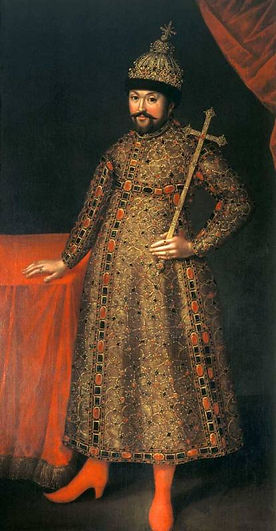
Mikhail Fedorovich Romanov (1596-1645),
son of Fedor Nikitich Romanov and
Xenia Shestova;
Tsar of Russia in 1613-1645
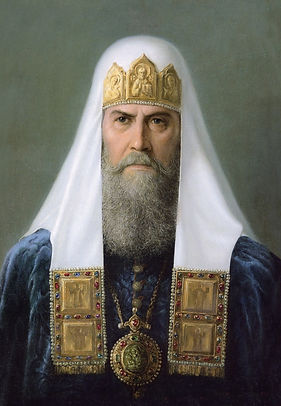
Fedor Nikitich Romanov, Filaret (1553-1633),
son of Nikita Romanov and
Eudoxia Gorbataya-Shyuskaya;
Patriarch of Moscow in 1619-1633

Eudoxia Lukyanovna Streshneva (1608-1645),
daughter of Lukyan Stepanovich Streshnev and Anna Konstantinovna Volkonskaya

Shein began surrender negotiations in January 1634, on 25 February the Russians finally signed a surrender treaty and on 1 March they vacated the camp. Back in Moscow, Shein was accused of incompetence and high treason and tried by the Boyar Duma. He was found guilty and executed on 28 April 1634. His estates were confiscated and his family exiled. After the relief of Smolensk in the spring of 1634, the Polish army moved towards the fortress Belaya. However, the siege of Belaya turned to a fiasco although Wladyslaw IV managed to capture Vyazma. Soon the Polish advance was abruptly stopped by the news that Murad IV, the Ottoman sultan, was invading Poland. On 17 May, Poland and Russia signed the Treaty of Polyanovka: Wladyslaw IV kept Smolensk, but agreed to surrender his claim to the Russian throne and return the royal insignia to Moscow
In 1639, two of Mikhail's sons, Ivan and Vasily, died almost simultaneously, one aged five and the other just after being born. In 1640, Mikhail's eldest daughter Irina was engaged to marry Valdemar Christian of Schleswig-Holstein, Prince of Denmark. He was sent to Russia for the wedding in 1644, but after arriving he refused to convert to the Orthodox faith. Valdemar was imprisoned until 1645, when he was allowed to leave Russia; Irina never married. The family tragedies took their toll on the tsar. In April 1645 he fell ill with scurvy, dropsy and probably depression. On 12 July, he fainted in church and his court realized that the tsar, now forty-nine, was dying. Eudoxia and Alexis were summoned: Mikhail said goodbye to his wife and blessed the heir with the kingdom. As he died, his cousin Nikita Ivanovich Romanov emerged into the chamber to be the first to take the oath of loyalty to the new tsar.